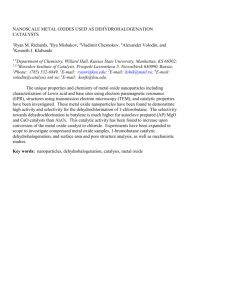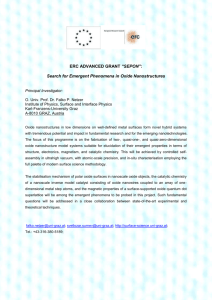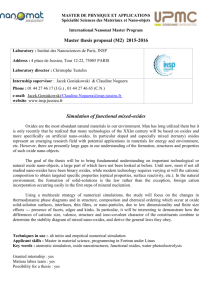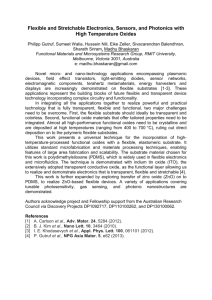It was a pleasure to meet you and your colleagues at last week`s
advertisement
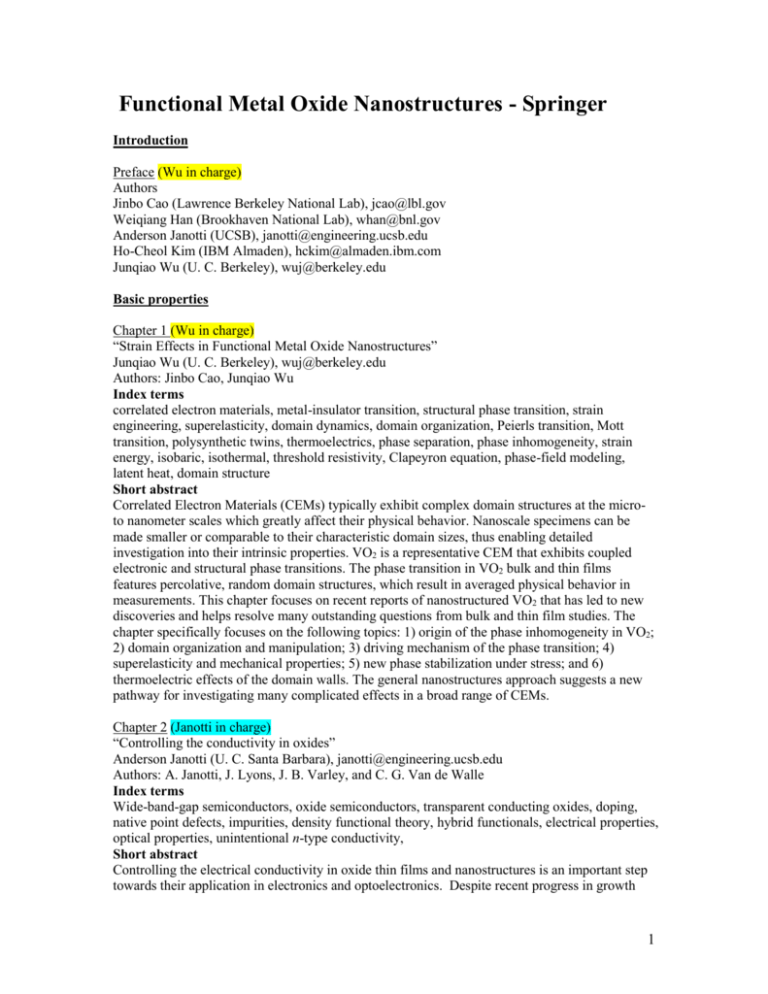
Functional Metal Oxide Nanostructures - Springer Introduction Preface (Wu in charge) Authors Jinbo Cao (Lawrence Berkeley National Lab), jcao@lbl.gov Weiqiang Han (Brookhaven National Lab), whan@bnl.gov Anderson Janotti (UCSB), janotti@engineering.ucsb.edu Ho-Cheol Kim (IBM Almaden), hckim@almaden.ibm.com Junqiao Wu (U. C. Berkeley), wuj@berkeley.edu Basic properties Chapter 1 (Wu in charge) “Strain Effects in Functional Metal Oxide Nanostructures” Junqiao Wu (U. C. Berkeley), wuj@berkeley.edu Authors: Jinbo Cao, Junqiao Wu Index terms correlated electron materials, metal-insulator transition, structural phase transition, strain engineering, superelasticity, domain dynamics, domain organization, Peierls transition, Mott transition, polysynthetic twins, thermoelectrics, phase separation, phase inhomogeneity, strain energy, isobaric, isothermal, threshold resistivity, Clapeyron equation, phase-field modeling, latent heat, domain structure Short abstract Correlated Electron Materials (CEMs) typically exhibit complex domain structures at the microto nanometer scales which greatly affect their physical behavior. Nanoscale specimens can be made smaller or comparable to their characteristic domain sizes, thus enabling detailed investigation into their intrinsic properties. VO2 is a representative CEM that exhibits coupled electronic and structural phase transitions. The phase transition in VO2 bulk and thin films features percolative, random domain structures, which result in averaged physical behavior in measurements. This chapter focuses on recent reports of nanostructured VO2 that has led to new discoveries and helps resolve many outstanding questions from bulk and thin film studies. The chapter specifically focuses on the following topics: 1) origin of the phase inhomogeneity in VO2; 2) domain organization and manipulation; 3) driving mechanism of the phase transition; 4) superelasticity and mechanical properties; 5) new phase stabilization under stress; and 6) thermoelectric effects of the domain walls. The general nanostructures approach suggests a new pathway for investigating many complicated effects in a broad range of CEMs. Chapter 2 (Janotti in charge) “Controlling the conductivity in oxides” Anderson Janotti (U. C. Santa Barbara), janotti@engineering.ucsb.edu Authors: A. Janotti, J. Lyons, J. B. Varley, and C. G. Van de Walle Index terms Wide-band-gap semiconductors, oxide semiconductors, transparent conducting oxides, doping, native point defects, impurities, density functional theory, hybrid functionals, electrical properties, optical properties, unintentional n-type conductivity, Short abstract Controlling the electrical conductivity in oxide thin films and nanostructures is an important step towards their application in electronics and optoelectronics. Despite recent progress in growth 1 and characterization, the causes of the often-observed unintentional conductivity in oxide semiconductors are still under debate. This chapter focuses on the theory of native defects and doping in oxide semiconductors such as ZnO, SnO2, and TiO2, from the perspective of firstprinciples calculations based on density functional theory, the DFT+U, and hybrid functionals. The possible causes of unintentional n-type conductivity and the prospects of achieving p-type doping are addressed. In the case of ZnO and SnO2, it is found that the unintentional conductivity is not due to oxygen vacancies or cation interstitials, but rather to the incorporation of donor impurities, with hydrogen being a likely candidate. In the case of TiO2, it is found that oxygen vacancies are shallow donors, but their formation energy is low only in extreme oxygen-poor conditions. Although the calculations were aimed at understanding the behavior of defects and impurities in bulk single crystals, the main results and conclusions are expected to be valid for thin films and nanostructures. Chapter 3 (Cao in charge) “The role of defects in functional oxide nanostructures” Authors Gavin Lawes (Wayne State Univ.), av4599@wayne.edu Authors: C. Sudakar, Shubra Singh, M.S. Ramachandra Rao, G. Lawes Index terms Defects, electron microscopy, carrier concentration, semiconductor, metal, metal-insulator transition, plasmon, photoluminescence, Raman spectroscopy, ferromagnetism, dilute magnetic semiconductor, spin polarization, nanostructures, nanoparticles, thin films, Kerr effect. Short abstract The properties of functional metal oxide nanostructures can be highly susceptible to the presence of defects. The defect concentration in these systems, which have exceedingly large surface-tovolume ratios, can be very high, potentially leading to qualitatively new phenomena beyond perturbing the existing characteristics. This chapter is focused on providing a brief overview of some of the new properties that can emerge in nanostructured oxides due to the presence of defects. This includes the development of metallic conductivity over a broad range of temperatures in oxygen vacancy defect-rich insulating oxide films. High charge carrier concentrations can also produce new collective optical phenomena, such as sharp plasmon resonances, as well as features in the photoluminescence. Remarkably, defects in semiconducting oxide nanostructures may also promote high temperature ferromagnetism, although there remains considerable debate concerning the underlying origins of this effect, including concerns about extrinsic effects. There are, however, a number of significant experimental observations on ferromagnetism in defect-rich semiconducting oxide nanomaterials, including direct low temperature measurements of the spin polarization. The plethora of physical phenomena associated with defects in metal oxide nanostructures allows the exciting possibility of introducing desired functionalities into these systems through controlled defect engineering. Chapter 4 (Cao in charge) “Electron transport in functional oxides with reduced dimensionality” An-Ping Li (Oak Ridge National Laboratory), apli@ornl.gov Authors: An-Ping Li and Thomas Z. Ward Index terms Correlated electron materials, quantum criticality, ruthenates, colossal magnetoresistance, manganites, metal-insulator transition, electronic phase transition, percolation transition, phase separation, electronic inhomogeneity, domain structure, strain engineering, domain dynamics, domain organization, Mott transition, scanning tunneling microscopy, electron transport, lowdimensional materials Short abstract 2 A prominent feature of complex oxides is the coexistence of competing electronic phases. The separation of metallic and insulating phases are believed to be responsible for a variety of emergent transport phenomena, including quantum criticality in ruthenates and colossal magnetoresistance in manganites. Interestingly, the phase boundaries between neighboring phases can often be displaced by small perturbations such as chemical doping, heating, stress, and electric or magnetic field, leading to intriguing metal-insulator transitions (MIT). The association of the emergent MIT with electronic inhomogeneities is particularly pronounced in lowdimensional materials which are uniquely suited to studying the MIT and phase evolutions in response to modification of the order parameters. Here, we present a few examples to illustrate the intimate interplay between emergent MIT and the competing electronic phases in functional metal oxide materials, including a percolative MIT near the critical temperature of the Mott transition in a Mn-doped bilayer ruthenate Sr3Ru2O7 crystal surface, and the abrupt conductance changes and reemergent MIT in manganite nanowires of La5/8-xPrxCa3/8MnO3. This experimental research has benefited from new developments in the fabrication and characterization of low-dimensional oxide materials and nanostructures. A rare glimpse of the microscopic phase separation, the dynamic phase percolation, and the strain-tuned MIT has been provided. The results indicate the critical role of electron-lattice interactions in phase separation and suggest that the origin of phase coexistence is much more strongly influenced by strain than local chemical inhomogeneity, both for ruthenates and manganites. Chapter 5 (Cao in charge) “Spectroscopic investigations of functional metal oxide nanostructures” Authors: Janice L. Musfeldt (Univ. Tennessee), musfeldt@ion.chem.utk.edu Index terms Transition metal oxides, Optical spectroscopy, Confinement model, Inhomogeneous media, Surface plasmon, Charge and bonding models, Mott transition, Charge order, Orbital order, Bound carrier excitation, Vanadium oxide nanoscrolls, Quantum size effects, Polar oxide thin film, Hydrogen binding, Metal-organic framework, Finite length scale effects Short abstract Transition metal oxides are celebrated for their novel properties. Just as physical and chemical tuning are at the heart of our ability to design, understand, and control advanced materials in their bulk form, size-shape tuning is of emerging importance in the field of functional oxide nanomaterials. This is because finite length scale effects (i) expand the usable structure-property phase space and (ii) can drive emergent phenomena. And in the same way that optical spectroscopy reveals the dynamics of bulk materials, it is beginning to do so in nanoscale compounds, particularly in combination with first principles calculations and various confinement models. This review takes the case study approach, highlighting recent findings in selected transition metal oxides where various types of length scale effects are important. Systems of interest include (i) the Mott-Hubbard compound VO2, (ii) La0.5Sr1.5MnO4 in high magnetic field, (iii) pristine and chemically-substituted vanadium oxide nanoscrolls, (iv) quantum size effects in ZnO and TiO2, (v) polar oxide thin films and nanoparticles based upon BiFeO3, and (vi) H2 binding in metal-organic frameworks. In these examples, efforts were made to bring simple chemical systems together with appropriate models of insulator-to-metal transitions, confinement, local strain, charge and bonding, excitons, and the role of defects for high level physical understanding of nanoscale texture, strain, and confinement. The overarching goals are to provide perspective for this emerging field and to outline prospects for optical spectroscopy to advance the fundamental understanding of functional oxides. Chapter 6 (Janotti in charge) “Electronic properties of post-transition metal oxide surfaces” Tim Veal (Univ. Warwick), Timothy.Veal@warwick.ac.uk> 3 Authors: T. D. Veal, P. D. C. King, and C. F. McConville Index terms Transparent conductors, transition-metal oxides, surfaces, x-ray photoelectron spectroscopy, angular-resolved photoelectron spectroscopy, Fermi-level pinning, surface electron accumulation layer, charge neutrality level, Hall effect, infrared reflectivity, optical absorption. Short abstract Metal oxides such as ZnO, Ga2O3, CdO, In2O3 and SnO2 exhibit high degree of transparency to visible light while supporting high levels electrical conductivity. The causes of the conductivity and the role played by the surface are current topics of research. This chapter presents a systematic study of the electronic structure and electrical properties of these post-transition metal oxides (PTMO) using a combination of x-ray photoelectron spectroscopy, angle-resolved photoelectron spectroscopy, Hall effect, infrared reflectivity, and optical absorption spectroscopy measurements. Evidence of surface electron accumulation in these PTMO is presented. It is found that for CdO and In2O3, electron accumulation is observed even in the absence of extremely high doping levels. The results also indicate that despite the strong tendency to exhibit surface electron accumulation, these materials can also exhibit an electron depletion layer under the appropriate surface stoichiometry conditions or when certain anions are adsorbed. The proclivity towards surface electron accumulation shown by the PTMOs is discussed in terms of bulk band structure, surface states, and the position of their band edges in an absolute energy scale. The electronic properties of thin films and bulk crystals of the PTMO surfaces also provide information vital for the interpretation of conductivity measurements of PTMO nanostructures, which are often dominated by surface effects. Chapter 7 (Janotti in charge) “In search of a truly two-dimensional metallic oxide” Priya Mahadevan (S.N. Bose National Centre for Basic Sciences), priya@bose.res.in; priya.mahadevan@gmail.com Authors: Priya Mahadevan, Kapil Gupta Index terms Metal-insulator transition, correlated electron materials, surface effects, thin films, strain engineering, density functional theory, DFT+U, two-dimensional electron gas, 4d transition metal oxides, Jahn-Teller distortion. Short abstract The existence of a metallic state and metal-insulator transition in two-dimensional (2D) systems has been an area that has attracted considerable attention, especially in view of theoretical considerations developed in the late 70’s and early 80’s which asserted on firm grounds that one could not have a metallic state in two dimensions. Since the slightest amount of disorder usually drives the system to an Anderson insulator, the origin of the metallic state discovered in the 90’s is still a puzzle. This chapter discusses results of density functional theory and DFT+U calculations for the electronic and magnetic ground state favored by 2D films of a 4d oxide which is both ferromagnetic and metallic in the bulk. Although the 4d oxides are usually not associated with strong correlation effects, interesting effects arise in the ultrathin limit. In particular, SrRuO3 is found to become an antiferromagnetic insulator, which evolves into a ferromagnetic metal with thickness. The thickness dependent insulator-metal transition takes place at four monolayers. The ultrathin limit represents the rare realization of a high spin state for Ru. The strong changes in the properties at this limit occur because the system becomes strongly localized and consequently strongly Jahn-Teller active. As a result, even a seemingly uncorrelated 4d oxide does not favor a metallic ground state. Synthesis and processing 4 Chapter 8 (Kim in charge) “Solution processed titania nanostructures” Ho-Cheol Kim (IBM Almaden), hckim@almaden.ibm.com Authors: Ho-Cheol Kim and John D Bass Index terms Titanium dioxide (TiO2), nanostructure, solution based process, microtransfer molding, water soluble template, poly(vinyl alcohol), sol-gel, self-assembly, photovoltaics, ellipsometry, electrofilling, anodization, nanoimprint lithography, 3-dimensional fabrication, mulitlayers, solfilling, block copolymer lithography, electrochemical deposition, hydrothermal growth, anatase, rutile, heterojunction, catalysis, nanomaterials Short abstract Titanium dioxide (TiO2) finds a prominent role in many emerging high tech domains, where the ability to control structure on the nanometer scale is opening new possibilities in areas such as photonics, membranes, sensing and environmental applications. Solution phase synthesis of titania nanostructures is an attractive route to achieve well-defined, functional nanomaterials materials at low cost. Such solution phase synthesis has a number of advantages in terms of process control, ease of handling, and flexibility. Of particular interest is the creation of 1-D structures such as rods, wires, pillars, nanotubes, nanofibers, that have unique advantages, such as improved charge collection and lower tortuosity. In other applications, including photonics, catalysis, and sensing, controlling 3-D structures on one or more length scales is desirable. This chapter discusses a variety of recent strategies for the solution phase deposition of nanostructured TiO2 with specific emphasis on self-assembly, anodization, transfer molding, electrodeposition, and hydrothermal growth, each showing their own promises and challenges. Chapter 9 (Kim in charge) “Oxide-Based Photonic Crystals from Biological Templates” Michael Bartl (University of Utah), bartl@chem.utah.edu Authors: Michael H. Bartl, Jeremy W. Galusha, Matthew R. Jorgensen, Lauren R. Richey, John S. Gardner Index Terms. Bioinspiration, biotemplating, macrostructured oxides, photonic crystals, photonic band gap, top-down and bottom-up fabrication, sol-gel chemistry, atomic layer deposition, conformal-evaporated-film-by-rotation, butterflies, beetles, iridescence Short abstract The world of insects is full of structural colors, lending butterfly wings, bird feathers and beetle scales their strikingly iridescent appearance. Since many of the structures behind these optical effects are so-called photonic crystals, they have recently attracted the interest of optical engineers and scientists as unique structural templates. This chapter aims to discuss recent developments in replicating biological structures into oxide-based photonic crystals operating at visible frequencies. Following a brief introduction into the physics and properties of photonic crystals, this chapter will focus on the following topics: 1) recent advances and limitations of topdown and bottom-up photonic crystal engineering routes; 2) examples and properties of biological photonic crystals; 3) conversion of biological structures into oxide-based replicas by deposition methods (atomic layer deposition and conformal-evaporated-film-by-rotation) and solgel chemistry routes. The chapter will conclude with an outlook on the potential of biotemplating for the achieving complete photonic band gaps at visible frequencies. Chapter 10 (Janotti in charge) “Low-dimensionality and epitaxial stabilization in metal supported oxide nanostructures” Cesare Franchni (Universitat Wien), cesare.franchini@univie.ac.at Authors: Cesare Franchni Index terms 5 Scanning tunneling microscopy, atomic force microscopy, low-energy electron diffraction, x-ray photoelectron spectroscopy, electron energy loss spectroscopy, density functional theory, hybrid functionals, metal oxides, surface, oxide nanolayers, epitaxial growth. Short abstract This chapter presents a survey of the growth and structure of manganese oxide nanolayers on a Pd(100) substrate, investigated in two different thickness regimes through a plethora of surface science techniques (STM, AFM, LEED, SPA-LEED, XPS, XAS, and HREELS) and state-of-theart theoretical tools based on density functional theory and hybrid functionals. The electronic and structural properties of the films are analyzed as a function of film thickness and growth conditions. Epitaxial (geometric) relationships that favor the growth of the different oxide phases are investigated, with special attention to the stability of the Mn3O4 (001)/MnO(001) interface and the phase stability diagram of MnxOy /Pd(100) phases at a Mn coverage of about 1 ML. A rich variety of two-dimensional (2D) nanophases, which are novel in terms of their structural and electronic properties, have been identified, which could play important role in mediating the epitaxial growth of MnO thicker films on Pd(100). Furthermore, the formation of O or Mn vacancies drives the transition between 2D phases with similar structural units but different lattice periodicity, indicating that ion vacancies, mixed valence states and substoichiometry lie at the basis of the architectural flexibility in the monolayer regime. Interestingly, the latter concepts play a major role in the more complex class of functional oxides such as the manganites, of which binary manganese oxides are the simplest parent compounds. Applications Chapter 11 (Han in charge) “Oxygen-deficient nano metal-oxide and their energy applications” Weiqiang Han (Brookhaven National Lab), whan@bnl.gov Authors: Weiqiang Han Index terms non-stoichiometric , oxygen deficient, metal oxide, ceria, titania, chromium oxide, substoichiometric, water-gas shifting reaction, Magnéli phases, modulation structure, onedimensional, nanotubes, nanowires, nanobelts, nanocavities, cation, anion, fuel cell, electron energy loss spectrum, Transmission electron microscopy , X-ray diffraction, X-ray absorption near edge structure Short abstract Metal oxides are usually non-stoichiometric. Non-stoichiometry affects their physical properties and chemical reactivity and can lead to novel devices and new applications in renewable energies. This chapter introduces two types of oxygen-deficient metal oxides. The first is nonstoichiometric oxygen-deficient one-dimensional nano-ceria (CeO2-x) and non-stoichiometric oxygen-deficient TiO2-x nanowires with nanocavities; the second is sub-stoichiometric Magnéli phases TinO2n-1 (4≤ n ≤ 10) nanowires and sub-stoichiometric Cr2O2.4 nanobelts with modulation structures. The application of 1D-nano-ceria for water-gas shifting reaction also is detailed. Chapter 12 (Wu in charge) “Oxide Nanostructures for Energy Storage” Yi Cui (Stanford University), yicui@stanford.edu Authors: Yuan Yang, Jang Wook Choi, Yi Cui Index terms Lithium-ion batteries, supercapacitors, high power, high energy materials, lithium intercalation, conversion reactions, electrical double layer, surface redox reaction, in-situ charaterization, single nanowire measurement, solid electrolyte interphase, electrolyte stability, phase transformation, nanowires, nanoparticles, core/shell structure, surface coating, porous materials. 6 Short abstract Solving energy issues is one of the greatest challenges in the 21st century. Energy storage is critical as it plays an important role in almost every aspect of energy applications. Batteries and electrochemical capacitors are the most widely used energy storage devices, such as in portable devices, power tools, electric vehicles and smart grids. However, devices with better performance, such as higher energy density, longer cycle life, and faster charge/discharge rate, are still desired. Novel materials are crucial to achieve these goals. In view of this, nanostructured materials offer great promise because of the unusual properties from their small dimensions and the combination of bulk and surface properties to the overall behavior. In this chapter, the effect of nanostructure on various oxide materials in batteries/capacitors will be discussed. In general, nanostructured materials significantly enhance the power capability of both batteries and capacitors. Moreover, cycle life and energy density are also improved for many oxides, especially those with conversion reactions. Chapter 13 (Kim in charge) “Metal Oxide Resistive Switching Memory” Philip Wong (Stanford University), hspwong@stanford.edu Authors: Shimeng Yu, Byoungil Lee, H.-S. Philip Wong Index terms resistance switching, resistive switching, RRAM, ReRAM, metal-insulator-metal, metal oxide, non-volatile memory, conductive filament, unipolar switching, bipolar switching, electroforming, dielectric breakdown, Joule-heating, metal-insulator-transition, redox, oxygen migration, resistance ratio, scalability, power consumption, switching speed, reliability, uniformity, cell selector, sneak path, crossbar array, cross-point memory, 3-D integration. Short abstract Electrically triggered resistance switching phenomenon in metal oxide was extensively explored for the promising potential as an emerging non-volatile memory. Prototype chips of large-scale array based on metal oxide memory are currently under development in industry. This chapter reviews the recent research progress of metal oxide memory specifically focusing on the following topics: 1) the underlying physics of resistance switching in metal oxides, including the experimental evidences of the filamentary conduction and oxygen ion/vacancy migration involved switching mechanism; 2) state of the art device characteristics and the key performance metrics such as resistance ratio, scalability, power consumption, switching speed, reliability and uniformity; 3) device cell structure design considerations for integration into large-scale highdensity crossbar memory arrays. Challenges and strategies for future optimization of metal oxide resistive switching memory technology were discussed. Chapter 14 (Han in charge) “Nanostructured metal oxides for Li-ion batteries” Chunsheng Wang (University of Maryland), cswang@umd.edu Authors: Juchen Guo and Chunsheng Wang Index terms Rechargeable batteries, Lithium-ion, three-dimensional nano-structures, one-dimensional nanowires, mesoporous structures, charge transfer, intercalation reaction, lithium titanium oxide, titanium oxide, conversion reaction, transition metal oxide, tin dioxide, lithium metal oxide cathode materials, lithium iron phosphate, miscibility gap, galvanostatic intermittent titration, polymer electrolyte, metal oxide composite, space charge theory Short abstract Lithium-ion battery is a promising electrochemical energy storage technology to meet the emerging energy demands. Metal oxides in their various nanostructures have been extensively investigated as electrode materials for Li-ion batteries due to their unique properties. In this 7 chapter, current investigations on metal oxides as anode materials are discussed based on their different reaction mechanisms to lithium. The latest studies on nano-structured lithium metal oxide cathode materials such as lithium iron phosphate are also discussed to provide some insight on their exceptional electrochemical performance. Request from Springer: For the following figures we are in need of revised figures to improve the quality as the image and text are pixilated and low resolution problem. Chapter 3 -Figures 2,6b Chapter 4 -Figures 4 ,5 Chapter 5- Figures 4,5b,6abcd,7abd Chapter 6 -Figure 3 Chapter 7- Figure 1 Chapter 8- Figures1,3,4,6,7,8,9,10,11 Chapter 9- Figures 4,11 Chapter 12- Figure 11a Chapter 13 -Figures 3,15b,15d and Table-01 Chapter 14- Figures 1,3 ,4 ,5,6,7 ,9 ,10 ,11 ,12. Example: Ch.14, Figure 12(b) is poor: 8



